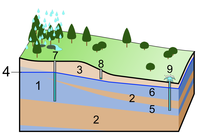
Photo from wikipedia
Abstract Transmitting fluids at high operating temperatures through buried pipelines is common in the oil and gas industry. Pipelines are insulated to maintain the fluid temperature within an operating threshold… Click to show full abstract
Abstract Transmitting fluids at high operating temperatures through buried pipelines is common in the oil and gas industry. Pipelines are insulated to maintain the fluid temperature within an operating threshold and reduce heat loss to the subsurface. In cold regions, damaged insulation around pipelines can raise ground temperatures by tens of degrees and keep ground frost free during the winter. This can lead to environmental and geotechnical issues, operational inefficiencies and, in extreme cases, pipeline failure. When supported by field data, modeling of coupled heat and water transfer in the subsurface can be used to understand baseline and disturbed ground temperatures and to design thermal remediation plans. However, simulating ground temperatures under the influence of snow cover, freeze-thaw conditions as well as a shallow heat source is challenging. This case study presents a simple and effective approach using a thermal boundary layer and a time-varying Dirichlet boundary condition to simulate these conditions with coupled vadose zone and groundwater models. The approach was validated by comparing the model results to a temperature survey along a boiler feed water pipeline corridor in northern Alberta, Canada. Model results were used to better understand the influence of high-temperature pipelines on subsurface thermal regimes, to help design a ground temperature monitoring program, and successfully identify and remediate pipeline insulation damage.
Journal Title: Cold Regions Science and Technology
Year Published: 2021
Link to full text (if available)
Share on Social Media: Sign Up to like & get
recommendations!